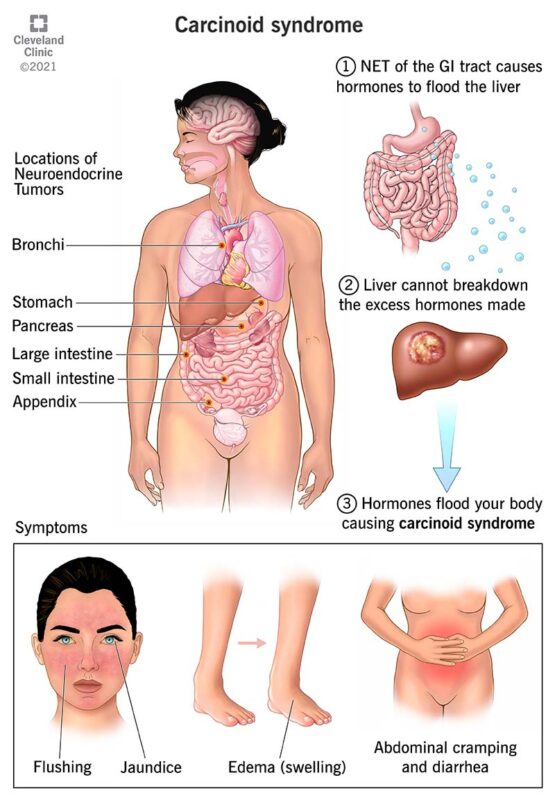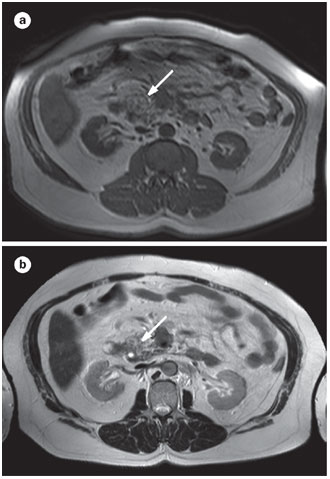Carcinoid cancer, a subtype of neuroendocrine tumors (NETs), is a rare and complex disease that arises from specialized hormone-producing cells found throughout the body. These tumors have the unique ability to secrete a variety of biologically active substances, leading to a constellation of symptoms known as carcinoid syndrome. Carcinoid cancer is often indolent in nature, with a slow growth pattern, but it can also exhibit more aggressive behavior, particularly in advanced stages.

The image is taken from the American Society of Clinical Oncology (ASCO)
Causes and Risk Factors of Carcinoid Tumor
- Genetic Syndromes:
- Neuroendocrine tumors, including carcinoid tumors, are more common in individuals with inherited genetic conditions such as multiple endocrine neoplasia type 1 (MEN1), neurofibromatosis type 1 (NF1), tuberous sclerosis complex (TSC), and von Hippel-Lindau (VHL) disease.
- Smoking:
- Tobacco use is believed to increase the risk of carcinoid tumors in the small intestine, as well as other forms of cancer.
- Age and Gender:
- Carcinoid tumors can occur at any age, but they are most commonly diagnosed in individuals between 40 and 60 years old, with a slightly higher incidence in women.
- Environmental Factors:
- While the specific environmental factors that contribute to the development of carcinoid tumors are not well-established, some research suggests that exposure to certain toxins or dietary factors may play a role.
It is important to note that the presence of one or more risk factors does not necessarily mean an individual will develop carcinoid cancer, and many people with carcinoid tumors have no known risk factors. However, awareness of these potential risk factors can help healthcare providers and patients be more vigilant in monitoring the development of carcinoid tumors and seeking timely medical attention.
The types of carcinoid tumor
Based on Location
Gastrointestinal Carcinoid Tumors: These are the most common type of carcinoid tumors, occurring within the digestive system. They can be found in the stomach, small intestine, colon, rectum, and appendix. Gastrointestinal carcinoid tumors may produce hormones like serotonin, leading to carcinoid syndrome in some cases.
Lung Carcinoid Tumors: Also known as bronchial carcinoid tumors, these develop in the lungs. They are categorized into typical and atypical carcinoids, with the former being more common and less aggressive than the latter.
Appendiceal Carcinoid Tumors: These tumors start in the appendix and are often discovered incidentally during appendectomies. They are generally slow-growing and less likely to produce symptoms unless they become large.
Based on Biological Behavior
Typical Carcinoids: These tumors are slow-growing and less likely to spread beyond their original site. They are more common and account for about 90% of lung carcinoid tumors. Typical carcinoids rarely produce carcinoid syndrome unless they metastasize to the liver.
Atypical Carcinoids: These grow slightly faster than typical carcinoids and have a higher likelihood of spreading to other organs. Atypical carcinoids are characterized by more cells that are dividing and appear more like a fast-growing tumor. They are less common than typical carcinoids.
Symptoms of Carcinoid Tumor
The clinical presentation of carcinoid cancer can be highly variable, depending on the primary tumor location, the extent of disease, and the specific hormones and bioactive substances secreted by the tumor.
- Asymptomatic Presentation:
- Many carcinoid tumors are initially asymptomatic and are discovered incidentally during imaging or surgical procedures performed for other reasons.
- Carcinoid Syndrome:
- Carcinoid syndrome is the most well-known clinical manifestation of carcinoid cancer and occurs in approximately 10-30% of patients with carcinoid tumors.

This image is taken from my.clevelandclinic.org
- Carcinoid syndrome is caused by the excessive secretion of serotonin and other vasoactive substances, such as histamine, prostaglandins, and tachykinins, by the tumor.
- The classic symptoms of carcinoid syndrome include:
- Flushing: Sudden, episodic reddening of the face, neck, and upper body, often triggered by stress, exercise, or certain foods.
- Diarrhea: Watery, voluminous, and often debilitating diarrhea.
- Bronchoconstriction: Wheezing, shortness of breath, and bronchial constriction.
- Cardiac complications: Valvular heart disease, particularly right-sided heart failure due to fibrotic changes in the tricuspid and pulmonary valves.
- Carcinoid syndrome is the most well-known clinical manifestation of carcinoid cancer and occurs in approximately 10-30% of patients with carcinoid tumors.
- Other Symptoms:
- Depending on the primary tumor location, patients may experience additional symptoms, such as:
- Abdominal pain, nausea, and vomiting (for gastrointestinal carcinoid tumors)
- Cough, chest pain, and hemoptysis (for pulmonary carcinoid tumors)
- Pelvic pain and menstrual irregularities (for ovarian carcinoid tumors)
- Depending on the primary tumor location, patients may experience additional symptoms, such as:
It is important to note that not all carcinoid tumors are associated with the classic carcinoid syndrome, and some patients may present with non-specific symptoms or even be asymptomatic, particularly in the early stages of the disease
Diagnosis of Carcinoid Tumor
The diagnosis of carcinoid cancer involves a comprehensive approach that includes various tests and procedures to confirm the presence of the tumor and determine its characteristics. Common diagnostic methods for carcinoid cancer include:
- Blood Tests:
- Blood tests can detect high levels of hormones secreted by carcinoid tumors or byproducts created when those hormones are broken down by the body.
- Elevated levels of specific biomarkers, such as chromogranin A (CgA), may indicate the presence of a carcinoid tumor.
- Urine Tests:
- Urine tests can identify excess levels of chemicals produced when the body breaks down hormones secreted by carcinoid tumors.
- A 24-hour urine collection to measure 5-hydroxy-indole-acetic acid (5-HIAA) is often used to diagnose functional neuroendocrine tumors, including carcinoid tumors.
- Imaging Tests:
- Imaging tests, such as computed tomography (CT) scans, magnetic resonance imaging (MRI), positron emission tomography (PET), X-rays, and nuclear medicine scans, help pinpoint the location of the carcinoid tumor.
- Endoscopic procedures, including endoscopy, bronchoscopy, and colonoscopy, allow visualization of the tumor and collection of tissue samples for biopsy.

MRI scans of a patient with metastatic carcinoid tumor. A T1-weighted image that shows low signal density (arrow), which contrasts with the T2-weighted image of the same tumor. b | T2-weighted image that exhibits high signal density (arrow). This image is taken from Researchgate.net
- Biopsy:
- Tissue samples from the tumor are collected through biopsy procedures to confirm the diagnosis of carcinoid cancer and determine the type and aggressiveness of the tumor.
- Biopsy samples are sent to a laboratory for histopathological analysis to identify the types of cells in the tumor and assess their aggressiveness.
In summary, the diagnosis of carcinoid cancer involves a combination of blood tests, urine tests, imaging studies, endoscopic procedures, and biopsy to confirm the presence of the tumor, determine its location, and guide treatment decisions. Early and accurate diagnosis is essential for initiating appropriate management and improving patient outcomes.
Treatment of Carcinoid Tumor
- Surgical Treatment:
- Surgical resection is the primary and potentially curative treatment for localized carcinoid tumors.
- Surgical options include enucleation, partial pancreatectomy, and more extensive procedures like the Whipple operation, depending on the tumor location and extent of disease.
- Somatostatin Analogues:
- Somatostatin analogs, such as octreotide and lanreotide, are the first-line agents for managing the symptoms of carcinoid syndrome.
- These drugs can help control the secretion of hormones and other bioactive substances, alleviate symptoms, and potentially slow tumor growth.
- Targeted Therapies:
- The targeted drug everolimus (Afinitor) has been shown to be effective in treating advanced gastrointestinal carcinoid tumors.
- Everolimus can be used alone or in combination with somatostatin analogs.
- Chemotherapy:
- Chemotherapy is generally not very effective for most gastrointestinal carcinoid tumors, but it may be used for tumors that are high-grade or have spread to other organs.
- Commonly used chemotherapeutic agents include capecitabine, 5-fluorouracil, doxorubicin, etoposide, and streptozocin.
- Regular monitoring and assessment of the patient’s response to chemotherapy are essential to make any necessary adjustments to the treatment plan.
- The oncology team evaluates the patient’s response to treatment and may recommend additional therapies, such as surgery or immunotherapy, as needed.
- Other Supportive Therapies:
- Antidiarrheal medications, such as loperamide or diphenoxylate, can help manage the diarrhea associated with carcinoid syndrome.
- Interferon alpha has also been used to help control symptoms and potentially slow tumor growth.
The treatment approach for carcinoid cancer is tailored to the individual patient, taking into account factors such as the primary tumor location, extent of disease, and the presence of carcinoid syndrome. A multidisciplinary team of healthcare providers, including endocrinologists, surgeons, and oncologists, collaborates to develop the most appropriate treatment plan for each patient.
Prognosis and Survival
The prognosis and survival rates for patients with carcinoid cancer can vary depending on several factors, including the stage of the tumor, the extent of the disease, and the primary tumor location. In summary, the prognosis and survival rates for patients with carcinoid cancer are generally favorable, especially when the tumors are localized or regional. Early diagnosis, appropriate treatment, and close monitoring are essential for improving outcomes and enhancing the quality of life for individuals with carcinoid cancer.
Challenges and Considerations
- Delayed Diagnosis:
- The non-specific and variable symptoms of carcinoid tumors can lead to delays in diagnosis, often resulting in the detection of advanced-stage disease.
- Increasing awareness and education among healthcare providers and the general public is crucial to facilitate earlier diagnosis and improve patient outcomes.
- Tumor Heterogeneity:
- Carcinoid tumors exhibit significant heterogeneity, both within individual tumors and across different patients, which can complicate treatment selection and response prediction.
- Ongoing research aims to better understand the molecular and genetic drivers of carcinoid tumor development and progression, with the goal of developing more personalized treatment approaches.
- Resistance to Conventional Therapies:
- Some carcinoid tumors may develop resistance to traditional treatment modalities, such as somatostatin analogs and chemotherapy, highlighting the need for novel therapeutic strategies.
- Exploring the potential of emerging targeted therapies, immunotherapies, and combination approaches is an active area of research in the field of carcinoid cancer.
- Rare and Atypical Presentations:
- Carcinoid tumors can occur in unusual anatomical locations, such as the ovaries, prostate, and thymus, which can present unique diagnostic and management challenges.
- Continued research and the establishment of disease registries and collaborative networks are essential to better understand the natural history and optimize the care of patients with rare and atypical carcinoid presentations.
- Quality of Life Considerations:
- The chronic and debilitating nature of carcinoid syndrome, as well as the side effects of various treatments, can significantly impact the quality of life of patients with carcinoid cancer.
- Addressing the physical, emotional, and psychosocial needs of these patients, through a multidisciplinary approach that includes supportive care and patient-reported outcomes, is crucial for improving overall well-being.
By addressing these challenges and continuing to advance the field of carcinoid cancer research and care, healthcare providers can strive to provide more effective, personalized, and holistic management strategies for patients affected by this rare and complex disease.
During Treatment
Common side effects include:
- Chemotherapy Side Effects:
- Chemotherapy can cause nausea and vomiting, hair loss, mouth sores, diarrhea or constipation, increased chance of infections, easy bruising or bleeding, and fatigue.
- Somatostatin Analog Side Effects:
- Somatostatin analogs like octreotide and lanreotide can cause nausea, abdominal bloating, and fatty stools (steatorrhea).
- Radiation Therapy Side Effects:
- Radiation therapy can cause skin changes, hair loss, fatigue, and mouth sores.
- Targeted Therapy Side Effects:
- Targeted therapy with everolimus (Afinitor) can cause diarrhea, fatigue, rash, mouth sores, and swelling of the legs or arms.
- Interferon Side Effects:
- Interferon alfa may cause flu-like symptoms, such as fever, headache, and muscle aches.
- Other Side Effects:
- Other side effects of carcinoid cancer treatment include gallstone formation, difficulty breathing, and changes in appetite and weight.
- Managing Side Effects:
- Healthcare providers can help manage side effects by prescribing medications, adjusting treatment plans, and providing supportive care.
Management Strategies
- Surgery:
- Surgery is a primary treatment option for carcinoid tumors, especially when detected early. Complete surgical removal of the tumor can be curative.
- Surgeons may attempt to remove as much of the tumor as possible in advanced cases to help control signs and symptoms.
- Medications:
- Medications like octreotide and lanreotide are used to control excess hormones secreted by the tumor, reducing the signs and symptoms of carcinoid syndrome and slowing tumor growth.
- Telotristat may be used in combination with octreotide or lanreotide to further improve symptoms of carcinoid syndrome.
- Chemotherapy:
- Chemotherapy, which uses strong drugs to kill tumor cells, is recommended for treating advanced carcinoid tumors that cannot be removed with surgery.
- Targeted Drug Therapy:
- Targeted drug treatments focus on specific abnormalities within tumor cells, causing them to die. This therapy is usually combined with chemotherapy for advanced carcinoid tumors.
- Peptide Receptor Radionuclide Therapy (PRRT):
- PRRT combines a drug that seeks out cancer cells with a radioactive substance that kills them. It delivers radiation directly to cancer cells and may be an option for people with advanced carcinoid tumors.
- Liver-Directed Therapies:
- Treatments for carcinoid tumors that spread to the liver may include surgery to remove part of the liver, hepatic artery embolization, radiofrequency ablation, and cryoablation.
These management strategies aim to control symptoms, slow tumor growth, and improve the quality of life for individuals with carcinoid tumors. The choice of treatment depends on factors such as tumor location, stage, hormone secretion, overall health, and patient preferences.
After Treatment
Follow-up Care
- Frequency of Follow-up:
- After surgery, patients typically have an appointment with their doctor or specialist nurse within 2-6 weeks of being discharged.
- Thereafter, follow-up appointments are scheduled every 3-6 months, especially for patients who had carcinoid tumors that had spread to other parts of the body.
- Patients who had successful surgical removal of the carcinoid tumor may have less frequent follow-up visits.
- Monitoring and Assessments:
- During follow-up appointments, the doctor or nurse will examine the patient, ask about any symptoms or side effects, and order relevant blood tests and imaging scans.
- Patients are encouraged to contact their healthcare team between appointments if they have any new concerns or symptoms 1.
- Emotional Support:
- Follow-up appointments can be anxiety-provoking for some patients, and they are encouraged to share their worries with their support system or seek counseling if needed.
- Multidisciplinary Approach:
- The follow-up care for carcinoid cancer patients often involves a multidisciplinary team, including endocrinologists, surgeons, oncologists, and other specialists.
- Importance of Adherence:
- Consistent follow-up and adherence to the recommended schedule are crucial for early detection of any recurrence or complications, allowing for timely intervention.
- Individualized Care:
- The frequency and duration of follow-up are tailored to the individual patient’s needs and the specific characteristics of their carcinoid tumor.
By maintaining regular follow-up care, patients with carcinoid cancer can be closely monitored, and any issues or concerns can be addressed promptly, ultimately improving their overall health outcomes.
Recommendations for Patients
- Regular Follow-up:
- Patients should have regular follow-up appointments with their healthcare team, especially after surgical treatment.
- The frequency of follow-up visits may vary depending on the individual case, but it is typically every 3-6 months.
- Symptom Monitoring:
- Patients should be vigilant in monitoring for any new or recurring symptoms, such as those associated with carcinoid syndrome, and report them to their healthcare team.
- Dietary Modifications:
- Patients may need to consume carbohydrate-rich meals or snacks every 2-3 hours to help maintain stable blood glucose levels.
- Exercise Precautions:
- Patients should be cautious with physical exercise, as it can exacerbate symptoms associated with carcinoid syndrome.
- Medication Adherence:
- If prescribed medications like somatostatin analogs or targeted therapies, patients should take them as directed and report any side effects to their healthcare team.
- Multidisciplinary Care:
- Patients should be managed by a multidisciplinary team, including endocrinologists, surgeons, oncologists, and other specialists, to ensure comprehensive and coordinated care.
- Emotional Support:
- Patients may benefit from emotional support and counseling, as the diagnosis and management of carcinoid cancer can be anxiety-provoking.
- Prompt Reporting of Changes:
- Patients should promptly report any changes in their condition or new symptoms to their healthcare team, as this can facilitate timely intervention and treatment adjustments.
By following these recommendations, patients with carcinoid cancer can actively participate in their care, optimize their treatment outcomes, and improve their overall quality of life.
Resources
- National Cancer Institute – cancer.gov
- American Cancer Society – cancer.org
- American Society of Clinical Oncology (ASCO) – Cancer.net
- Memorial Sloan Kettering Cancer Center – mskcc.org
- Guidelines for the diagnosis and management of carcinoid tumors – PubMed
- Neuroendocrine Tumor Research Association – netrf.org
- National Organization of Rare Disorders – rarediseases.org
- Cancer Research UK – cancerresearchuk.org
- Management of Carcinoid Tumors – annalsthoracicsurgery.org
- Canadian Cancer Society – cancer.ca
- Everything about cancers – Oncodaily.com
